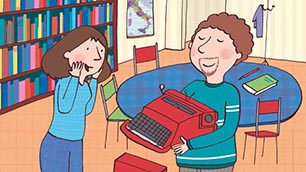| Silvia: | Let’s now explore the verb essere, which corresponds to the English verb to be. Essere, like to be in English, is an irregular verb whose conjugation follows a special pattern. In English we say: I am, you are, he is, she is and so on. You stop using the word “be” once you start conjugating verbs. The same thing happens in Italian with essere, which is also an irregular verb. Let’s now conjugate essere in the present tense of the indicative mood:
| I am | - | io sono | | You are | - | tu sei | | He/she is | - | lui/lei/Lei è | | We are | - | noi siamo | | You are | - | voi siete | | They are | - | loro sono |
As you may have noticed, I said “you are” twice, but gave you two different Italian translations, namely: “tu sei” and “voi siete”. |
| Connor: | Sì, I did notice that! |
| Silvia: | Well, in Italian there is a polite form for “you”. We say "Lei" instead of "tu" in formal speech, whereas we use "tu" among friends, people of the same age and to address children. |
| Connor: | So, should I use “tu” or “Lei” when speaking to you? |
| Silvia: | “Tu” is fine. And thank you for asking, Connor, you are molto gentile. |
| Connor: | Gentile? Molto?... |
| Silvia: | Molto gentile means very kind. You will need to expand your vocabulary, Connor. I will be introducing more words as we go on. |
| Connor: | This is exciting! I like it! |
| Silvia: | Bene! I’m glad you like my plan! Why don’t we start by pairing essere with the words you already know? If you don’t know how to say something in Italian, just say it in English. Let me go first. Io sono una professoressa di italiano. |
| Connor: | OK, let me try… io sono Connor! Io sono American! |
| Silvia: | Ah! Ah! Connor! Io sono americano, with an “o”. |
| Connor: | Oh, I see… that reminds me of an old song that went: Tu vuò fà l’americano! So, great, A-me-ri-ca-no is the correct word, now I know it! |
| Silvia: | Try something with “tu sei”. |
| Connor: | Tu sei a girl… ragazza! |
| Silvia: | Molto bene! Tu sei molto gentile. |
| Connor: | Io sono molto gentile. Tu sei… funny! |
| Silvia: | Tu sei simpatica. Grazie Connor! Sei uno studente. |
| Connor: | What? |
| Silvia: | I’m sorry? |
| Connor: | You said “sei uno studente”. I didn’t hear you saying “tu”, but I guess you’re referring to me, am I right? |
| Silvia: | You are right and I’m actually very happy you noticed that! In Italian, personal pronouns are optional. I can say: “sono Silvia”, because “sono” already indicates that I am the subject of the sentence. So, remember, only use a personal pronoun, such as "io", for example, when you really want to emphasize the subject performing the action. |
| Connor: | So, I can say “sono Connor”, “sono americano” and “sono gentile”. |
| Silvia: | Correct! Now, let’s try to use “lui è” - “he is” and “lei è” - “she is”. |
| Connor: | Lei è bella! Lei è romantic! Lui è happy! |
| Silvia: | Lei è romantica. Lui è felice. |
| Connor: | Romantica… Felice… sounds so poetic! |
| Silvia: | Well, dear Connor, molto bene, so far! I’m very happy with our first lesson! Let’s get an espresso and come back to practice noi siamo, voi siete and loro sono. |





















